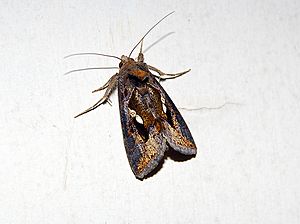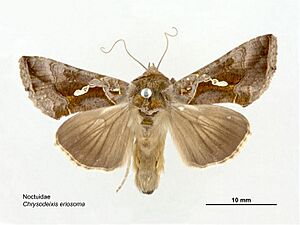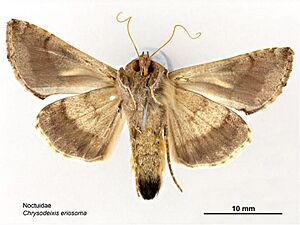Green garden looper facts for kids
Quick facts for kids Green garden looper |
|
|---|---|
 |
|
| Scientific classification | |
| Kingdom: | |
| Phylum: | |
| Class: | |
| Order: | |
| Family: | |
| Genus: |
Chrysodeixis
|
| Species: |
C. eriosoma
|
| Binomial name | |
| Chrysodeixis eriosoma (Doubleday, 1843)
|
|
| Synonyms | |
|
Plusia eriosoma Doubleday, 1843 |
|
The green garden looper (scientific name: Chrysodeixis eriosoma) is a type of moth. It belongs to the family Noctuidae, which includes many kinds of owlet moths. This moth is found in many parts of the world, making it a "cosmopolitan" species. You can find it in places like Japan, China, India, Sri Lanka, Malaysia, Australia, and New Zealand. It has also been seen in Hawaii and even in North America and Russia.
The green garden looper looks very much like another moth called Chrysodeixis chalcites. They are so similar that scientists sometimes call them "sibling species." This means they are very closely related.
Contents
What Does the Green Garden Looper Look Like?
Adult Moths
Adult green garden looper moths have a wingspan of about 42 millimeters (about 1.6 inches). Some of these moths can be much darker in color than others.
It can be tricky to tell the green garden looper apart from other similar moths. For example, it differs from C. signata because its head, body, and front wings often have a reddish tint. Its wings also have more shiny, golden areas.
It's almost impossible to tell the green garden looper (C. eriosoma) and Chrysodeixis chalcites moths apart just by looking at them. However, scientists can tell them apart by looking at their DNA. They can also use special chemicals called pheromones or by knowing where the moth was found. C. chalcites is usually found in cooler northern parts of the world. C. eriosoma lives in warmer, tropical and subtropical areas of eastern Asia and the Pacific islands, including Australia and New Zealand. These moths are common in farms and open areas, even high up in mountains.
Larvae (Caterpillars)
The young stage of the moth is called a larva, which is a caterpillar. These caterpillars are green. They have several faint white lines running along their backs and sides. Sometimes, they also have small black dots on their sides.
Like many caterpillars in their group, they are missing two pairs of their special "prolegs." These are small, fleshy legs found on the belly of a caterpillar. Because they are missing some, they move in a unique way, like an "inchworm" or "looper." They arch their body up in the middle as they move forward. These caterpillars can grow to be about 4 centimeters (about 1.5 inches) long. They are known to eat many different kinds of plants, over sixty species in total!
Life Cycle of the Green Garden Looper
The green garden looper goes through different stages in its life. After the caterpillar stage, it turns into a pupa. This is a resting stage where the caterpillar changes into an adult moth. The pupa stage can last for different amounts of time. In summer, it might only be a few days. But in winter, it can last for about a month.
Why is the Green Garden Looper a Pest?
The green garden looper is considered a pest because its caterpillars eat many important crops. They can cause damage to plants like tomatoes, potatoes, beans, cabbage, and cotton. This can be a big problem for farmers.



